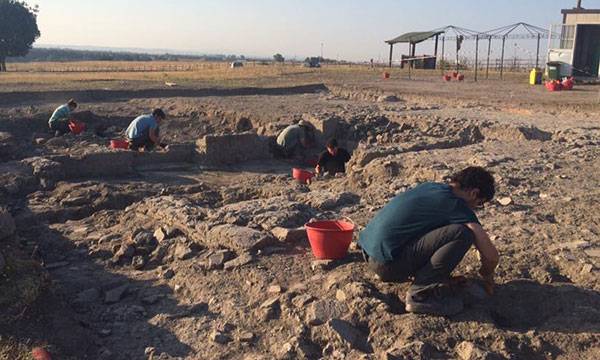
A team of Duke scholars and students spent this summer at two historic sites in Italy and made significant discoveries. The team, based in part in the dig@lab, a digital laboratory run by Maurizio Forte, a professor of classical studies and art, art history and visual studies, discovered two Roman Empire-era facilities, a public building and an amphitheater.
The project team included Duke faculty members Bill Seaman, David Johnston, Todd Berreth and Regis Kopper, as well as Nevio Danelon, a post-doctoral fellow; Katherine McKusker, PhD student; Benedict Parfit, an undergraduate student. Everette Newton, who works with Duke’s Nicholas School of the Environment’s marine lab, piloted the drone used in the excavation. The team also included scholars from other universities.
Sponsored by the National Geographic Society/Waitt Grants Program and Duke’s Bass Connections, the team used drones, virtual reality 3D modeling and other high-tech tools at both sites. In Vulci, this summer’s discovery came the old-fashioned way – through excavation. At Reggio Emilia, the “A-Ha” moment came courtesy of newer technology, as drones took overhead images examined using ground-penetrating radar to spot layers of hidden civilizations beneath the surface.
In an email conversation with Duke Today, Forte discussed the discoveries of a Roman public building in Vulci and a Roman amphitheater in Reggio Emilia. Here are excerpts:
Q: You and an archaeology team from Duke have made two significant discoveries this summer in Italy. Were these surprising finds or were you looking for them specifically?
FORTE: In the first case we knew of the existence of an important building, but we couldn’t know the chronology and the architectural features which identify it as a probable religious building.
In the second case, yes, we were looking for it specifically. We started the archaeological prospections with the idea that it was possible to recognize important Roman buildings underneath and possibly an amphitheater, but it was a great surprise to see a well designed elliptic shape over 10 meters deep!! The amphitheater is overlapped by a 14th century wall known as the citadel.

Q. What sort of technologies are you using during this project, and how has it benefited your research?
FORTE: In the first project at Vulci we used geophysical prospections before the excavation. This approach was very successful since we had a preliminary map of the underneath buildings before the excavation. During the excavation we use digital photogrammetry, virtual reality, 3D modeling and robotic tools for the virtual/digital reconstruction of the entire excavation and stratigraphic layers. The archaeological excavation is completely paperless: we had three different teams in charge of the digital documentation on site, in the digital lab and in the ceramic lab (by 3D laser scanners).
Our drone was able to collect more than 12,000 aerial photos of the archaeological park, which let us re-contextualize the site with its archaeological landscape. The aerial survey was able to recognize unknown sites and monumental buildings of the Roman Forum and the Etruscan city.
Q: How much specific information can you glean about the two discoveries? Do you know roughly how old they are, what they were used for, that sort of thing? What can you learn from them?
FORTE: The archaeological excavation in Vulci is still in progress; it will take several years for a full understanding of the findings. However, the large, possibly religious. building we found in Vulci and the discoveries of other large walls tell us about the importance of this area and reveal the configuration of the Roman Forum in relation with preexisting Etruscan buildings.
At the moment we date the retrieval pits covering the buildings at the middle of the 4th century AD (possibly the last Roman phase) and a public building at the 2nd to 1st century BCE. The use of marbles from Asia Minor and Northern Africa show the importance of the building and the economic power of the Roman city.
The discovery of the amphitheater (in Reggio Emilia) is outstanding, but it is based only on geophysical prospections. Additional investigations are required for dating the building and having a detailed insight of the monument.
Q: At Vulci this summer you did what might be called ‘traditional’ excavation. At Reggio Emilia, you used geophysical prospections -- ground-penetrating radar -- to look beneath the surface. These seem like two vastly different methods.
FORTE: This is the marvelous world of technologies where sometimes it is possible to interpret sites without digging. Let’s compare archaeology and medicine. Diagnostic techniques such as MRI can discover very precisely what’s wrong in the human body, for example a cancer, but the surgery can actually confirm it and act inside the human body to remove it.
Similarly, you can use geophysical prospections in archaeology and you get preliminary interpretations (the amphitheater) and/or you can dig and find specific buildings/monuments, date them and reconstruct their entire life (Vulci). Geophysics is like MRI, while excavation is like surgery.
Below, Everette Newton and Maurizio Forte with a drone used at the Vulci site.
